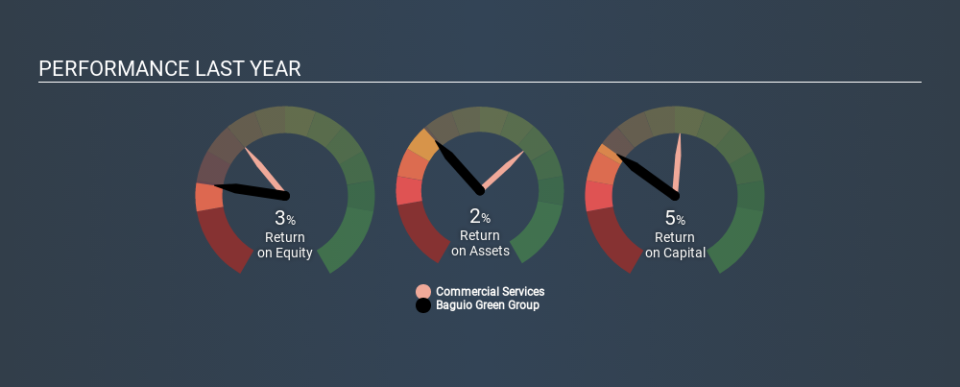Why We’re Not Impressed By Baguio Green Group Limited’s (HKG:1397) 5.5% ROCE

Today we'll look at Baguio Green Group Limited (HKG:1397) and reflect on its potential as an investment. To be precise, we'll consider its Return On Capital Employed (ROCE), as that will inform our view of the quality of the business.
First, we'll go over how we calculate ROCE. Next, we'll compare it to others in its industry. And finally, we'll look at how its current liabilities are impacting its ROCE.
Understanding Return On Capital Employed (ROCE)
ROCE is a measure of a company's yearly pre-tax profit (its return), relative to the capital employed in the business. In general, businesses with a higher ROCE are usually better quality. Ultimately, it is a useful but imperfect metric. Renowned investment researcher Michael Mauboussin has suggested that a high ROCE can indicate that 'one dollar invested in the company generates value of more than one dollar'.
So, How Do We Calculate ROCE?
The formula for calculating the return on capital employed is:
Return on Capital Employed = Earnings Before Interest and Tax (EBIT) ÷ (Total Assets - Current Liabilities)
Or for Baguio Green Group:
0.055 = HK$17m ÷ (HK$734m - HK$433m) (Based on the trailing twelve months to June 2019.)
Therefore, Baguio Green Group has an ROCE of 5.5%.
Check out our latest analysis for Baguio Green Group
Does Baguio Green Group Have A Good ROCE?
ROCE is commonly used for comparing the performance of similar businesses. Using our data, Baguio Green Group's ROCE appears to be significantly below the 11% average in the Commercial Services industry. This performance could be negative if sustained, as it suggests the business may underperform its industry. Separate from how Baguio Green Group stacks up against its industry, its ROCE in absolute terms is mediocre; relative to the returns on government bonds. Readers may find more attractive investment prospects elsewhere.
Baguio Green Group's current ROCE of 5.5% is lower than its ROCE in the past, which was 13%, 3 years ago. This makes us wonder if the business is facing new challenges. You can see in the image below how Baguio Green Group's ROCE compares to its industry. Click to see more on past growth.
It is important to remember that ROCE shows past performance, and is not necessarily predictive. ROCE can be deceptive for cyclical businesses, as returns can look incredible in boom times, and terribly low in downturns. This is because ROCE only looks at one year, instead of considering returns across a whole cycle. You can check if Baguio Green Group has cyclical profits by looking at this free graph of past earnings, revenue and cash flow.
What Are Current Liabilities, And How Do They Affect Baguio Green Group's ROCE?
Liabilities, such as supplier bills and bank overdrafts, are referred to as current liabilities if they need to be paid within 12 months. The ROCE equation subtracts current liabilities from capital employed, so a company with a lot of current liabilities appears to have less capital employed, and a higher ROCE than otherwise. To counteract this, we check if a company has high current liabilities, relative to its total assets.
Baguio Green Group has total assets of HK$734m and current liabilities of HK$433m. Therefore its current liabilities are equivalent to approximately 59% of its total assets. Baguio Green Group has a fairly high level of current liabilities, meaningfully impacting its ROCE.
What We Can Learn From Baguio Green Group's ROCE
Even so, the company reports a mediocre ROCE, and there may be better investments out there. Of course, you might also be able to find a better stock than Baguio Green Group. So you may wish to see this free collection of other companies that have grown earnings strongly.
For those who like to find winning investments this free list of growing companies with recent insider purchasing, could be just the ticket.
If you spot an error that warrants correction, please contact the editor at editorial-team@simplywallst.com. This article by Simply Wall St is general in nature. It does not constitute a recommendation to buy or sell any stock, and does not take account of your objectives, or your financial situation. Simply Wall St has no position in the stocks mentioned.
We aim to bring you long-term focused research analysis driven by fundamental data. Note that our analysis may not factor in the latest price-sensitive company announcements or qualitative material. Thank you for reading.

 Yahoo News
Yahoo News 

